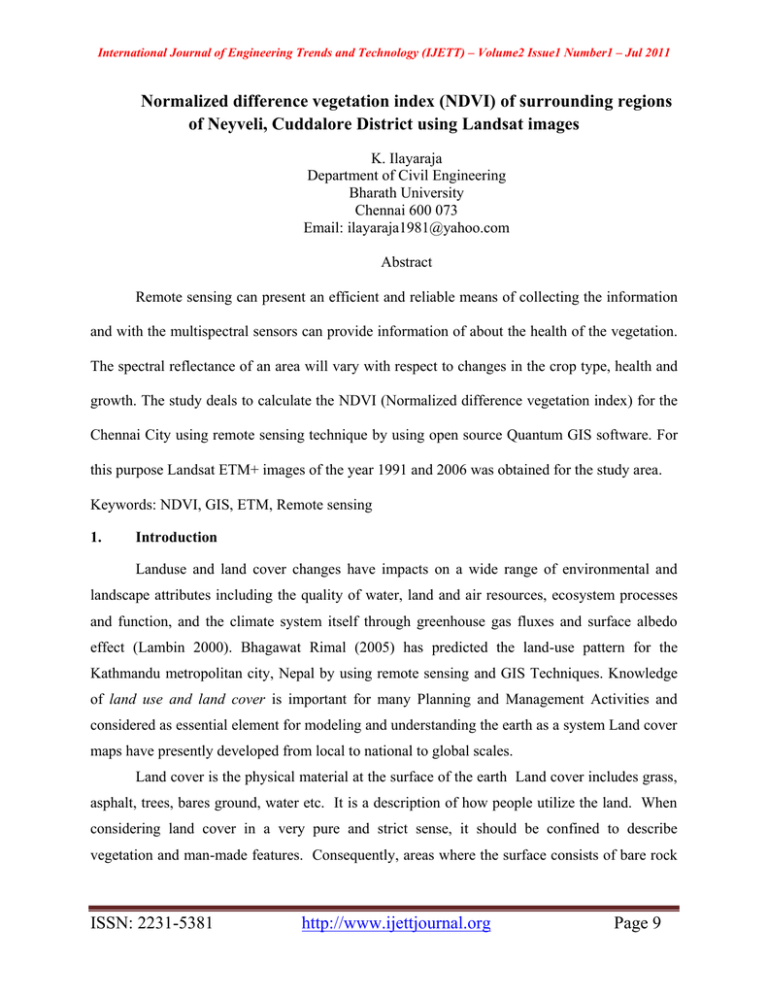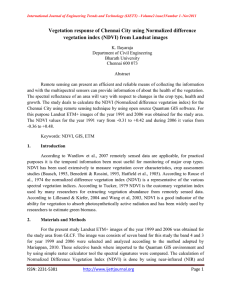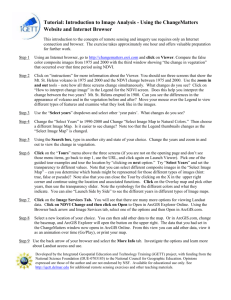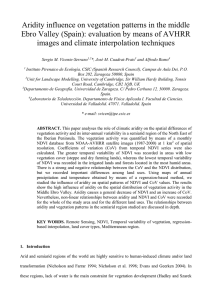Document 12932514
advertisement

International Journal of Engineering Trends and Technology (IJETT) – Volume2 Issue1 Number1 – Jul 2011 Normalized difference vegetation index (NDVI) of surrounding regions of Neyveli, Cuddalore District using Landsat images K. Ilayaraja Department of Civil Engineering Bharath University Chennai 600 073 Email: ilayaraja1981@yahoo.com Abstract Remote sensing can present an efficient and reliable means of collecting the information and with the multispectral sensors can provide information of about the health of the vegetation. The spectral reflectance of an area will vary with respect to changes in the crop type, health and growth. The study deals to calculate the NDVI (Normalized difference vegetation index) for the Chennai City using remote sensing technique by using open source Quantum GIS software. For this purpose Landsat ETM+ images of the year 1991 and 2006 was obtained for the study area. Keywords: NDVI, GIS, ETM, Remote sensing 1. Introduction Landuse and land cover changes have impacts on a wide range of environmental and landscape attributes including the quality of water, land and air resources, ecosystem processes and function, and the climate system itself through greenhouse gas fluxes and surface albedo effect (Lambin 2000). Bhagawat Rimal (2005) has predicted the land-use pattern for the Kathmandu metropolitan city, Nepal by using remote sensing and GIS Techniques. Knowledge of land use and land cover is important for many Planning and Management Activities and considered as essential element for modeling and understanding the earth as a system Land cover maps have presently developed from local to national to global scales. Land cover is the physical material at the surface of the earth Land cover includes grass, asphalt, trees, bares ground, water etc. It is a description of how people utilize the land. When considering land cover in a very pure and strict sense, it should be confined to describe vegetation and man-made features. Consequently, areas where the surface consists of bare rock ISSN: 2231-5381 http://www.ijettjournal.org Page 9 International Journal of Engineering Trends and Technology (IJETT) – Volume2 Issue1 Number1 – Jul 2011 or bare soil are describing land itself rather than land cover. Land use is the human use of land and it is the description of how people utilize the land. According to Wardlow et al., 2007 remotely sensed data are applicable, for practical purposes it is the temporal information been most useful for monitoring of major crop types. NDVI has been used extensively to measure vegetation cover characteristics, crop assessment studies (Bausch, 1993, Benedetti & Rossini, 1993, Hatfield et al., 1985). According to Rouse el al., 1974 the normalized difference vegetation index (NDVI) is a representative of the various spectral vegetation indices. According to Tucker, 1979 NDVI is the customary vegetation index used by many researchers for extracting vegetation abundance from remotely sensed data. According to Lillesand & Kiefer, 2004 and Wang et al, 2003, NDVI is a good indicator of the ability for vegetation to absorb photosynthetically active radiation and has been widely used by researchers to estimate green biomass. 2. Materials and Methods For the present study Landsat ETM+ images of the year 1999 and 2006 was obtained for the study area from GLCF. The image was consists of seven band for this study the band 4 and 3 for year 1999 and 2006 were selected and analyzed according to the method adopted by Mariappan, 2010. These selective bands where imported to the Quantum GIS environment and by using simple raster calculator tool the spectral signatures were compared. The calculation of Normalized Difference Vegetation Index (NDVI) is done by using near-infrared (NIR) and visible (VIS) (Mariappan, 2010). The resultant obtained will be the single band dataset were the values will be ranging between -1.0 and 1.0 where lower values corresponds to correspond to built structures, barren areas of rock or sand, whereas moderate and high values represent sparse and dense vegetation (Esri, 2008). 3. Study area The Neyveli power station has founded in 1956. Neyveli Lignite Corporation limited is a government owned lignite mining and power generating company in India. NLC operates the largest open pit lignite mines in India presently mining 24MT of lignite and has an installed capacity of 2740MW of electricity the union government holds 93% shares of NLC and is administered through Ministry of coal NLC has well developed town ship in Neyveli district of Cuddalore Tamilnadu. It is located at 11.30 degree North 79.29 degree East figure 2. Today the township covers 53 square KM provide around 18000 houses for the employees The town is ISSN: 2231-5381 http://www.ijettjournal.org Page 10 International Journal of Engineering Trends and Technology (IJETT) – Volume2 Issue1 Number1 – Jul 2011 surrounded by several water bodies on its southern portion. The national high way from Chennai to Thanjavore NH45A runs north to south of the town and other state highways which runs from cuddalore to Trichy runs in the west direction of the town The northern part of the town is mainly occupied by the settlements and southern part is occupied by waterbodies. Mines which are present in central part of the township play a very important role in our study. The area occupied by mines is increasing year by year shows the major change in landuse and landcover pattern. The major railway networks are connected in this area. 4. Results and Discussion The pixel values of the NDVI data layer range from -1 to +1. The higher NDVI values indicate increase in biomass per unit area and the layer is presented in Fig. 1. In this figure, the NDVI values for the year 1991 vary from -0.43 to +0.61. The NDVI values for the year 2006 vary from -0.42 to +0.55. The positive values represent different types of vegetation classes, whereas near zero and negative values indicate non-vegetation classes, such as water, and barren land (Fig. 2). It has been noted that the values which are greater than 1 represent the low as well as the dense vegetation. In this study it is identified that is a reduction of vegetation cover during the year 2006 may be due the increase of settlements within the study area. Figure 1. NDVI index during 1991 ISSN: 2231-5381 http://www.ijettjournal.org Page 11 International Journal of Engineering Trends and Technology (IJETT) – Volume2 Issue1 Number1 – Jul 2011 Figure 2. NDVI index during 2006 5. Conclusion Remote sensing data are pretty good for classification of urban areas. An attempted has been made to classify the reflectance characteristics of remote sensing data by using open source Quantum GIS software. It has been noted that the values which are >1 represent the low as well as the dense vegetation. These data sets can provide base line details of the study area. Therefore, the use of ancillary datasets in addition to remote sensing data has been recommended. References Bausch, Walter C. (1993): Soil Background Effects on Reflectance-Based Crop Coefficients for Corn. (1991). Remote Sensing of the Environment. 46:213-222. Benefetti, Roberto; Paolo Rossini. (1993): On the Use of NDVI Profiles as a Tool for Agricultural Statistics: The case Study of Wheat Yield Estimates and Forecast in Emilia Romagna. Remote Sensing of the Environment. 45:311-326. Hatfield, J.L.; Kanemasu, E. T.; Asrar, G.; Jackson, R. D.; Pinter, P. J. Jr.; Reginato, R. J.; and Idso, S. B. (1985): Leaf Area Estimates from Spectral Measurements Over Various Planting Dates of Wheat. International Journal of Remote Sensing. 6:167- 175. ISSN: 2231-5381 http://www.ijettjournal.org Page 12 International Journal of Engineering Trends and Technology (IJETT) – Volume2 Issue1 Number1 – Jul 2011 Kamath, R (2000). Chennai Orient Blackswan. pp. 66. ISBN 978-81-250-1378-5. Mariappan N (2010) Net Primary Productivity Estimation of Eastern Ghats. International Journal of Geomatics and Geosciences 1(3) 406-413. Wardlow B. D., S. L. Egbert and J. H. Kastens, 2007. Analysis of time-series MODIS 250 m vegetation index data for crop classification in the U. S. Central Great Plains. Remote Sens. Environ. 108, 290-310. ISSN: 2231-5381 http://www.ijettjournal.org Page 13




